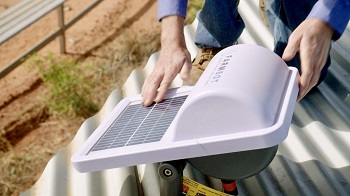Understanding your connectivity options
Australia’s AgTech industry continues to grow, providing producers with practical on-farm solutions to everyday challenges.
Remote water monitoring has obtained a strong foothold in Australia’s AgTech market, providing producers with near real-time information about their water infrastructure.

Benefits of remote water monitoring
- Provides producers with flexibility and peace of mind about their livestock’s water supply.
- Alerts producers to leaks or irregularities, giving them time to fix problems before livestock are impacted.
- Enables producers to spend less time manually checking water points, reducing labour and carbon footprint.
Key considerations when investing in AgTech
What should you consider when choosing an AgTech provider? Australian Agritech Association founding director and Farmbot managing director Andrew Coppin recommends you ask
providers and existing customers questions such as:
- How many devices are deployed and operating in your region?
- Is it a complete solution or just a piece of hardware that requires other elements (such as software) to fulfil its purpose?
- Can the device work with a computer as soon as it’s connected (‘plug and play’) or is a technician required to install it? If a technician is required, what are the costs of this, if any?
- Will there be ongoing costs? If so, how do these costs change according to the number of devices deployed?
- What are the maintenance requirements of devices? Are there any costs involved there?
- Is after-sales support available if needed? Is it easy for you to access?
You should also check the technology is fit-for-purpose and has reliable connectivity.
For more insights and tips, read: What producers should check before investing in AgTech (Beef Central).
What’s the difference between hardware and software?
- Hardware refers to the physical, tangible components of a system (such as a monitor or sensors).
- Software is intangible. It collects and processes data, converting it into a format that allows us to interpret it and understand what is happening.
Connectivity Options
It’s important for producers operating in rural areas to consider connectivity before investing
in AgTech. The solution you choose needs to suit the environment and your needs. Let’s take a look at three connectivity options offered in Australia.
Cellular uses one of the 4G/5G/LTE mobile networks to communicate monitoring information
Is this the option for you?
In areas with strong mobile connections, this is a reliable means of communication. However, it’s not the best option in areas with unreliable or non-existent connections.
Cost considerations
Much like a mobile phone, this method requires a subscription to access a data connection. Depending on the provider, the cost may increase with each monitoring device added to your network. Upfront costs for this technology are low because they can use the existing cellular network.
Satellite connections are used where 4G/5G/LTE do not have coverage or are unreliable.
Is this the option for you?
Satellite connectivity is quite common in rural areas with poor or non-existent cellular connections. It may be the best option to ensure your AgTech device reliably and continuously monitors and collects data.
Cost considerations
Like cellular, a satellite connection generally requires a paid subscription. Satellite is often a little more expensive than cellular connectivity, but costs have been on a downward trend.
Line of Sight uses one or more remote data gateways, which are installed in locations where there is no direct access
to the internet. The main data gateway(s) must have a direct connection to an internet router.
Is this the option for you?
Information is communicated through a network of data gateways, which are essentially antennas in paddocks. These
connect to an internet router, which is typically located in the home. Several data collection points can be established across your property, but they often need to be within about a 15-kilometre radius of each other.
Cost considerations
Where internet routers are already established on the property, communication capabilities can be set up with much lower ongoing costs. You only need to pay to maintain an internet connection at the central point. However, there are higher upfront costs to install data gateways in strategic locations across your property.
Where do I start?
Not sure which monitoring solution is right for you? Get a few quotes for a comparable system and conduct a cost comparison over 10 to 15 years. Make sure you consider additional monitoring points and the implications they will have on the total cost of the solution. To get you started, here are some Australian companies that offer remote water monitoring solutions:
- OPS Australia offers data communications via line-of-sight technology. It’s based in Longreach in Queensland.
- Farmbot Monitoring Solutions offers satellite and cellular options. It’s based in Naremburn in New South Wales.
- Goanna Ag utilises satellite connectivity.
- Observant can be accessed from any internet connected mobile device, tablet, or computer
Acknowledgement: This article is courtesy of Leading Sheep which is an initiative of Australian Wool Innovation and the Queensland Government and with support from AgForce.





